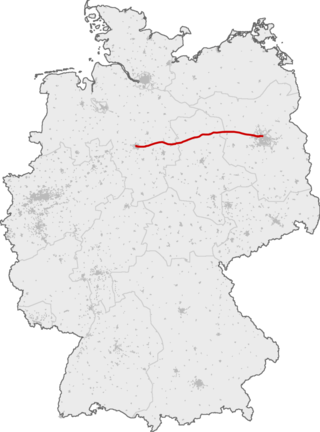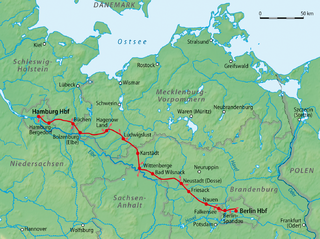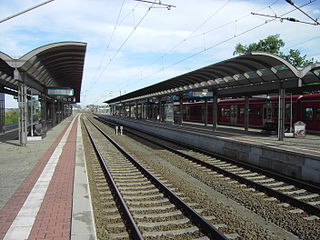Route

For information on the two halves of the route see: Stendal–Uelzen railway and Uelzen–Langwedel railway.
The America Line (German: Amerikalinie) is the official name of a railway line in northern Germany which is mainly of regional importance today. It runs in an east-west direction and links Stendal in Saxony-Anhalt with the Hanseatic city of Bremen.
The America Line was originally the central element of direct links from Magdeburg and, most importantly, Berlin to the North Sea ports. It was given its colloquial name because many emigrants from East and West Prussia, Silesia and the provinces of Posen and Pomerania travelled on the line to Bremerhaven, where there was a connexion to emigration ships sailing to America at the "Old" and "New" Lloydhalle and Kaiserhafen and Nordenham Lloydpier until the WW1, later, since 1928, on the Columbus Quay (Columbuskaje). In the opposite direction, many goods trains laden with fresh fish ran from Bremerhaven to the capital of the German Reich. Because Kaiser Wilhelm II occasionally travelled on this route from Berlin to the naval bases on the North Sea, it is sometimes also called the Emperor Line (Kaiserlinie). Several express trains ran on this line on the route from Berlin–Wilhelmshaven to Berlin–Norddeich. During the Cold War, the line was cut next to Nienbergen station as a result of the creation of the Inner German border.
The Lower Saxon town of Uelzen is the historical and geographical centre point of the route, and the point at which it is divided from an operational and timetable point of view. The eastern section of the route is now electrified and upgraded, whereas the western section is mostly non-electrified and also known as the Uelzen Railway (Uelzener Bahn).

For information on the two halves of the route see: Stendal–Uelzen railway and Uelzen–Langwedel railway.

The Hanover–Berlin high-speed railway is a 258-kilometre (160 mi) high-speed rail line linking the German cities of Hanover and Berlin.

The Heath Railway is a regional railway line in North Germany that crosses the Lüneburg Heath from which it derives its name. Most of the line is unelectrified and single-tracked. It links Buchholz in der Nordheide with Hanover, the capital city of Lower Saxony. Together with the east-west Uelzen–Langwedel railway, this north-south line is one of the two most important railways on the heath.
The Bremen State Railway was a railway line built by the Free Hanseatic City of Bremen on Prussian state territory. In spite of its name and although owned by the state it was operated under Prussian law as a private railway. Constructionally it formed the 97 km long Uelzen–Langwedel railway, the western section of the America Line.

The Uelzen–Langwedel railway runs through the Lüneburg Heath in north Germany in an east-west direction. The line became known as part of the so-called America Line.

The Brunswick–Uelzen railway line is a largely, single-tracked, non-electrified branch line in the north German state of Lower Saxony. It serves the northern part of Brunswick Land and the eastern region of the Lüneburg Heath. The most important station en route is Gifhorn. The line has also been called the Mühlenbahn for several years due to the many mills along its route.

The Berlin–Hamburg Railway is a roughly 286 km (178 mi) long railway line for passenger, long-distance and goods trains. It was the first high-speed line upgraded in Germany to be capable of handling train speeds of over 200 km/h (120 mph).

Soltau (Han) station is in the town of Soltau in the German state of Lower Saxony, located in the centre of the Lüneburg Heath. As a junction station on two railway lines, Hannover Hbf – Buchholz (Heath Railway) and Bremen Hbf – Uelzen (Uelzen–Langwedel railway), it is a central transport hub of the region and serves commuters and visitors to the Lüneburg Heath as a destination and transfer station.

Wustermark station is a railway station in the town of Wustermark in the Havelland region of the German state of Brandenburg, to the west of Berlin. The station is located on the Berlin–Lehrte railway and is connected with the Jüterbog–Nauen railway, part of which became part of the Berlin outer ring in the 1950s. It is classified by Deutsche Bahn as a category 5 station.

The Trebnitz–Leipzig railway is a double track electrified main line in the German states of Saxony-Anhalt and Saxony built and originally operated by the Berlin-Anhalt Railway Company. It formally starts at Trebnitz on the former border between the Duchy of Anhalt and Prussia and runs via Dessau and Delitzsch to Leipzig. The section from Bitterfeld to Leipzig is part of Line 1 of the Trans-European Transport Networks (TEN-T). Until 1871, the Zerbst–Roßlau section was called the Anhaltische Leopoldsbahn.

The Wunstorf–Bremen railway line is one of the most important lines in the German state of Lower Saxony. It connects the port city of Bremen via Verden an der Aller and Nienburg to Wunstorf, where it connects with the line to Hanover. The 122.3-kilometre-long (76.0 mi), twin-track main line is continuously electrified. The maximum speed is 160 kilometres per hour (99 mph), the maximum axle load is 22.5 tonnes (50,000 lb) and the line is rated as class D4 in the German system of track classification. It was opened on in 1847.

Oebisfelde is a railway station located in Oebisfelde, Germany. The station opened in 1871 and is located on the Berlin-Lehrte Railway. The train services are operated by Abellio Rail Mitteldeutschland.

Stendal is a railway station in the town of Stendal, Saxony-Anhalt, Germany. The station lies on the Berlin-Lehrte railway, Hanover–Berlin high-speed railway, Magdeburg-Wittenberge railway, Stendal–Uelzen railway, Stendal-Tangermünde railway and Stendal–Niedergörne railway. It is an important railway hub for regional trains and is also used by Intercity and Intercity-Express (ICE) trains regularly. Until the winter 2012 timetable Stendal station was only by Deutsche Bahn trains. Since December 2012, the station has also been served by some services operated by Ostdeutsche Eisenbahn. It is classified by Deutsche Bahn as a category 3 station.

The Bad Kleinen–Rostock railway is a double track electrified railway in the German state of Mecklenburg-Vorpommern. The Ludwigslust–Bad Kleinen section of the line is double track. The line was opened in 1850 by the Mecklenburg Railway Company and is one of the oldest railways in Germany and is part of the Leipzig–Magdeburg–Schwerin–Rostock main line.

The Magdeburg-Wittenberge railway is a two-track, electrified main line in the east of the German state of Saxony-Anhalt. It is one of the oldest lines in Germany, opened in 1849 by the Magdeburg-Wittenberge Railway Company, which operated it until 1863, when it was taken over by the Magdeburg-Halberstadt Railway Company. It was nationalised in 1879.

The Neudietendorf–Ritschenhausen railway connects Neudietendorf and Ritschenhausen in the German state of Thuringia. It is a mainly single-track main line operated by DB Netze.

Intercity (IC) is the second-highest train classification in Germany, after the Intercity Express (ICE). Intercity services are locomotive-hauled express trains, usually over long-distances. There are Intercity routes throughout Germany and routes generally operate every other hour, with multiple routes giving a more frequent service on core routes. Intercity services are operated by the DB Fernverkehr division of Deutsche Bahn, Germany’s national railway.

The Stendal–Uelzen railway is a mostly single-track, electrified main line and connects Stendal in the east of Altmark, Saxony-Anhalt with Uelzen in Lower Saxony. The most important stop along the way is Salzwedel.

Salzwedel station is the station of the district town of Salzwedel in Altmark in the German state of Saxony-Anhalt. Until 2004, it was a railway junction, but as a result of the closure of nearly all branch lines it has lost most of its importance. Only one railway line still runs through Salzwedel.
The Berlin Frankfurter Allee–Berlin-Rummelsburg railway is an electrified line in Berlin. It connects the Ringbahn with the Berlin-Betriebsbahnhof Rummelsburg station. Except for a short section, the line has two tracks. It was originally created as a freight line, but it is now used primarily used for the transfer of empty passenger trains that are maintained at the Rummelsburg depot. The track is also linked by a double-track line from the Ringbahn from the south to the Berlin-Lichtenberg station.